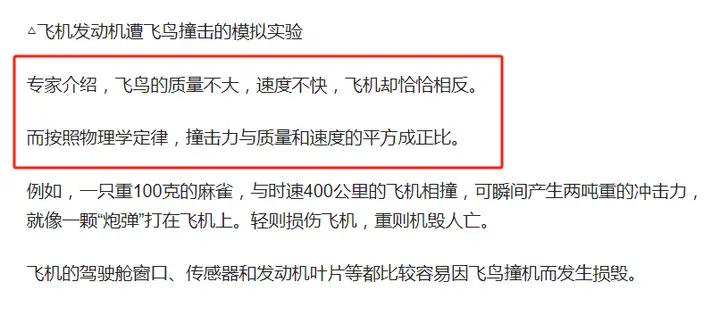Bird Strike Physics: Understanding Aircraft Safety
This analysis examines a media report that incorrectly applied Einstein’s mass-energy equation to bird strikes, while exploring the actual physics and safety implications of wildlife collisions in aviation.

The aerospace industry faces various safety challenges, with bird strikes remaining a significant concern for aircraft operators worldwide. A recent media report in China attempting to explain the physics behind bird strikes unfortunately missed the mark by incorrectly applying Einstein’s famous E=mc² equation to these collisions.
The fundamental physics of bird strikes is actually much simpler and relies on classical mechanics rather than relativistic physics. When a bird collides with an aircraft, the impact force depends primarily on three key factors: momentum, kinetic energy, and impulse.
The kinetic energy of the collision is proportional to the mass of the bird multiplied by the square of the relative velocity between the bird and aircraft. This relationship explains why strikes at higher speeds are particularly dangerous - doubling the speed quadruples the energy involved. However, this basic principle of motion has no connection to Einstein’s mass-energy equivalence formula.
Aviation safety statistics indicate that birds strikes occur frequently, with estimates ranging from 13,000 to 17,000 reported incidents annually worldwide. While most incidents cause minimal damage, strikes can occasionally result in serious consequences, particularly when birds are ingested into engines or damage critical flight surfaces.
The aviation industry has developed multiple layers of protection against bird strike risks. Modern aircraft engines undergo rigorous bird ingestion testing. Airports employ various wildlife management strategies, including habitat modification and active deterrence systems. Flight crews follow specific procedures when operating in areas of known bird activity.
While the media’s attempt to explain the physics was misguided, their broader point about bird strikes being a serious aviation safety concern is valid. The challenge lies in conveying technical information accurately while maintaining public interest. This requires careful fact-checking and consultation with subject matter experts before publication.
For public media outlets, the key to avoiding such scientific missteps is straightforward: rely on basic, well-established principles rather than attempting to incorporate complex physics concepts unnecessarily. When in doubt, direct quotes from aviation safety experts and actual incident data tell the story more effectively than potentially misleading technical explanations.
This incident serves as a reminder that scientific accuracy in media reporting requires both technical knowledge and editorial restraint. The goal should be to inform the public about genuine aviation safety concerns while avoiding sensationalism or misapplication of scientific principles.